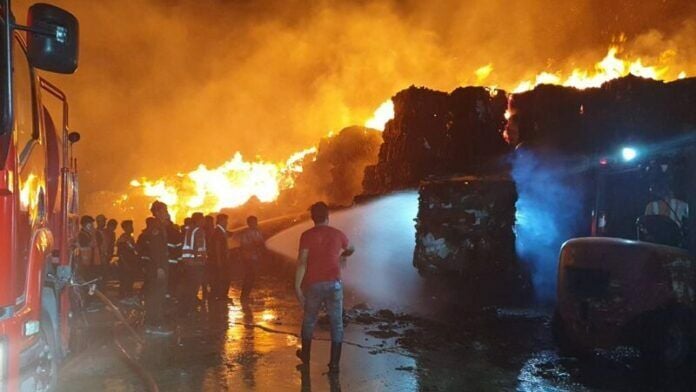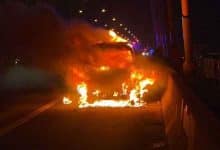Samut Sakhon recycling plant ablaze, emergency crews fight fire

A recycling plant in Samut Sakhon province has been engulfed in flames for over eight hours, with emergency services battling the blaze that has spread across the entire area. Nearly 20 fire trucks from Samut Sakhon and neighbouring Samut Songkhram provinces have been deployed to douse the intense fire that erupted in packed paper bales within the facility yesterday, April 30.
The conflagration at the paper recycling plant has been relentless, igniting three large stacks of recycled paper with fierce intensity. Local authorities had to coordinate a response involving nearly 20 fire engines from the surrounding areas to control the spread of the fire.
The Thai Disaster Response Association reported that, as of 1am, more than eight hours after the fire started, the flames continued to rage across the facility. The tightly packed paper bales served as excellent fuel for the fire, which was further exacerbated by strong winds, reported KhaoSod.
The fire reportedly broke out in an outdoor area behind the building, where old paper yet to be sorted was stored. The situation remains critical, with fire crews working tirelessly to extinguish the flames and prevent further damage. The cause of the fire is still under investigation, and no casualties have been reported thus far.
In related news, prompt investigations into the hazardous waste plant fire in Rayong‘s Ban Khai district have been demanded by Prime Minister Srettha Thavisin. The fire, which broke out at Win Process’ storage plant, has impacted the lives of 100 villagers since it started on April 22.
The 62 year old Thai prime minister voiced his concerns during a site visit on April 27, querying the duration it would take to unveil the cause of the fire.
Safety concerns have prevented local police from accessing the site for investigation purposes. While the fire currently remains under control, authorities have flagged the potential for a sudden flare-up. Interestingly, arson has not been dismissed as a potential cause for the fire, given the plant’s long-disconnected electricity supply.
Latest Thailand News
Follow The Thaiger on Google News:


























